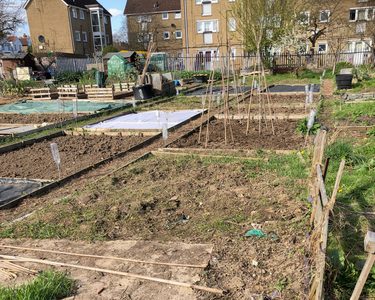Chris Collins on…taking on a new plot

It's a real mixture of Christmas day excitement and nerves when you manage to get your hands on a new allotment or veg plot. Allotments, in particular, tend to be abandoned and nature has moved in and reclaimed the space for itself.
So before you start work, the golden rule is remember why you’re doing it – and to have fun! Veg plots are about time to yourself, to grow some delicious food, enjoy beautiful flowers and be around nature - no matter your level of gardening ability. If the plot seems a little bit daunting, why not share it with another person or family? Many hands make light work and it's a great way to spend time with your family or community.
Learn about your soil 🔗
Chat to your neighbours, those with knowledge of the area, the soil, and general local conditions – as this could end up saving you a lot of time and effort.
Next, get your fingers in the soil and do a soil test. If it moulds into a ball, you’re dealing with clay , if it falls through your fingers then it’s sandy.
The good news with allotments is the soil is often in good nick having been worked by previous owners. However, this does not change priority number one: get a compost bin built out of some old pallets. These bins make sure you are replenishing the soil with goodness and wasting nothing.
Think about storage and collection 🔗
A decent shed or storage area is a must. Invest in some tools and make sure you have a potting bench where you can save and store seeds. It may sound obvious, but a well-organised workshop will help with your gardening immensely. Adding some cold frames for raising plants is a good idea. Start with these and once you become confident, maybe expand to a polytunnel.
A water butt is a must as tapping into nature’s bounty is good sustainable practice, and perfect back up in droughts.
Swot up on plants and planting plans 🔗
Divide up the growing space into manageable sections, creating pathways between them using recyclable materials. This also helps with rotating crops such a s brassicas and legumes that shouldn't be grown in the same soil every year.
Identify what plants are present (as the best you can), which you want, those you can tolerate, and which are going to need some work. There’s lots of organic ways to manage ‘weeds’, or wild plants in the wrong place.
You may want to practise no-dig by covering a section of ground with cardboard and compost for a period of time and then planting through it. This will reduce weeding further down the line as weed seeds remain below the surface, though it may be less practical if you have a heavy infestations of pernicious weeds such as horsetail. When it comes to these plants, it's a hands-on pulling and hoeing job to start things off.
Really overgrown areas can be reclaimed by planting lots of potatoes. As they grow they put out a canopy that shades out the weeds.
Then you can start choosing seeds! Ensure you grow what you’ll use so you don't waste time and effort on the plants you won’t eat. For me, there’s nothing like heritage varieties from our Heritage Seed Library - purely because they taste so much better.
Hardy annuals will provide colour and pollen, for a few pounds. And both heritage seeds and annuals can be collected and saved in the autumn for the following season’s bounty.
Make space for nature 🔗
Make sure there’s provision for nature. Is there a patch of nettles on the allotment that can be left to help out our moths and butterflies? They also make a great liquid fertiliser.
A dandelion or two will help with pollen for the bees early in the spring. Or you can add a strip of pollinator-friendly plants along the sides off your plot, or around edible crops. These will contribute hugely to a balanced plot that won’t be overrun with ‘pests’.
But above all, it’s important not to put pressure on yourself, or compete with others – just go at your own pace. Be excited about your new plot, take time to enjoy it!
Happy gardening, Chris